
Things to do in Dubrovnik Croatia
Made popular by the Game of Thrones series, Dubrovnik is a city on the southernmost tip of Croatia. Dubrovnik was named a UNESCO city for its Medieval walls but is there more to do in Dubrovnik than the city walls? Let me show you all the things to do in Dubrovnik Croatia, the historical sites, best islands and beaches to visit, foodie hot spots, how to visit locations free of crowds and how to save money.
Dubrovnik was founded by Roman Refugees in the 7th century, that called the city Ragusa. They outlawed slavery in the 14th century, survived two 18 month sieges by the Ottomans, created one of the first quarantine areas for Leprosy, built the city out of limestone to thwart the frequent fires, and has one of the oldest pharmacies in the WORLD that is still running.
I visited Dubrovnik in 2022 and updated this article in 2023 to include the most up to date information to plan your epic visit. Dubrovnik was the start of our 1500 mile road trip through the Balkans so make sure to check out those other articles.
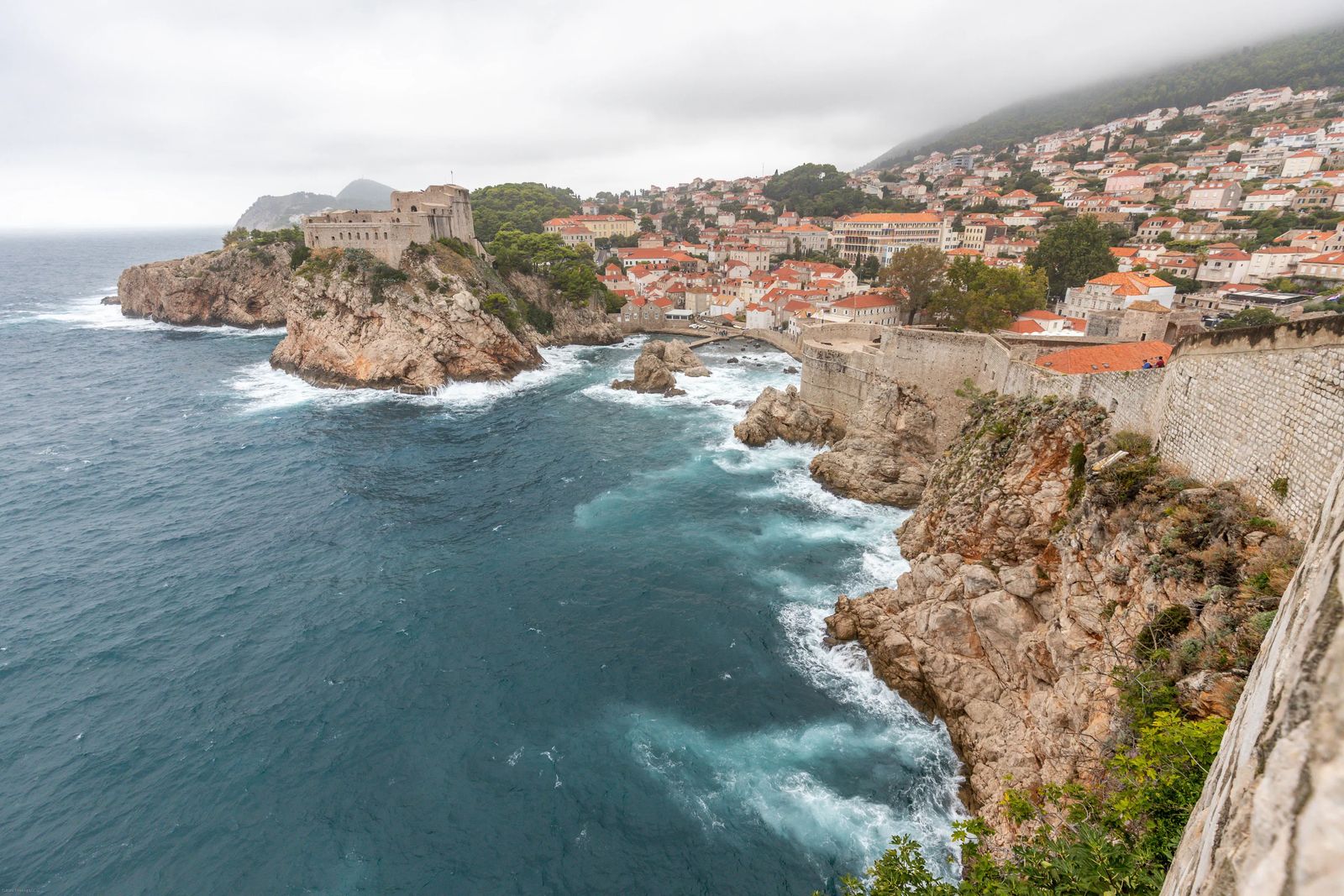
Walking The City Walls
The city walls of Dubrovnik are often considered a tourist trap, but for good reason. They are the main attraction that earned Dubrovnik the UNESCO site designation. However, keep in mind that getting up to the walkway can be quite challenging, involving about 100 steep steps and a potentially dangerous drop-off. If you have knee problems, it's best to take precautions before attempting to climb the stairs.
To access the walls, I recommend purchasing the Dubrovnik City Pass. With this pass, you can skip the line and head straight to the walls, while also saving money on other attractions mentioned in this article. The cost of walking the walls alone is approximately 30 Euros, and note that Croatia is transitioning to the Euro from the Kuna.
There are three entrances to the walls, but in my guided tour video, I entered at Pile Gate, which is the main gate. You can also enter at St. John's Fortress and St. Lucas Fortress. The time required to walk the walls varies, from a brisk 45-minute walk to a leisurely three-hour stroll that allows for taking in the breathtaking views.
When touring the walls, be aware that there is no shade along the way. If you're visiting on a sunny, hot day, it's essential to bring a wide-brimmed hat and sunscreen. A personal neck fan may also come in handy. However, I do not recommend bringing an umbrella as the walkway can get narrow in some areas, and it could potentially be hazardous to other visitors.
There are cafes along the wall, and a few bathrooms, as well as small garbage cans. The cafes can be quite expensive, for example, a fresh squeezed orange juice cost me about 7 Euros that was about 10oz.
The walk along the walls is about 1.2 miles (1940 m) with 1080 steps in total you will need to climb or descend. I would check to see when cruises come into port and plan your visit to the walls around that - by 10 am the walls were getting quite crowded and descending from the walls was a little scary sharing those stairs with people coming up the stairs. You can easily check cruise port docking times by visiting CruisetoPorts tool , Crew-Center.com List , or AvoidCrowds.com
If you enter from Pile gate, you will travel in an anticlockwise rotation with the first building being the Minceta Tower is (14th century) it is the highest point of the walls and has the best views of the old city (or Kings Landing views). You can see Lokrum island from here with the 1,000 year old Lovrijenac Fortress (Fort Lawrence) where you can go Kayaking to it or snorkeling near the island.
Dominican Monastery beneath you as you head to the Old Foundry Museum (open 10 am-5 pm) portion of the walls. While the museum isn't accessible from the wall walk, take note of where it is and visit this hidden gem of Dubrovnik later. This museum shows how the metallurgic forging helped shape the city, create gunpowder, cast bronze bells and moldings. The museum tells the story of the time of Ragusa's firepower program, developed in secrecy from the Venetian and Ottoman empires. The museum can be hard to find, it is behind a small wooden door next to the basketball court.
You can see Lokrum island from here with the 1,000 year old Lovrijenac Fortress (Fort Lawrence).
You will pass the Turret of the upper corner tower, then the turret of the tower of St Francis. Then the Pile bastion and Pile outer gate watching tourists stream through it into the city onto the main walkway, the stradun. Then it is onto the Puncoela Tower, and then Bokar Fortress.
On the West side is the Dubrovnik Old Town walls in Bokar Fortress, circular in shape and used to help defend Pile Gate.
St John's Fortress is on the southeast corner (Mulo Tower) and this tower defended the city from pirate ships.
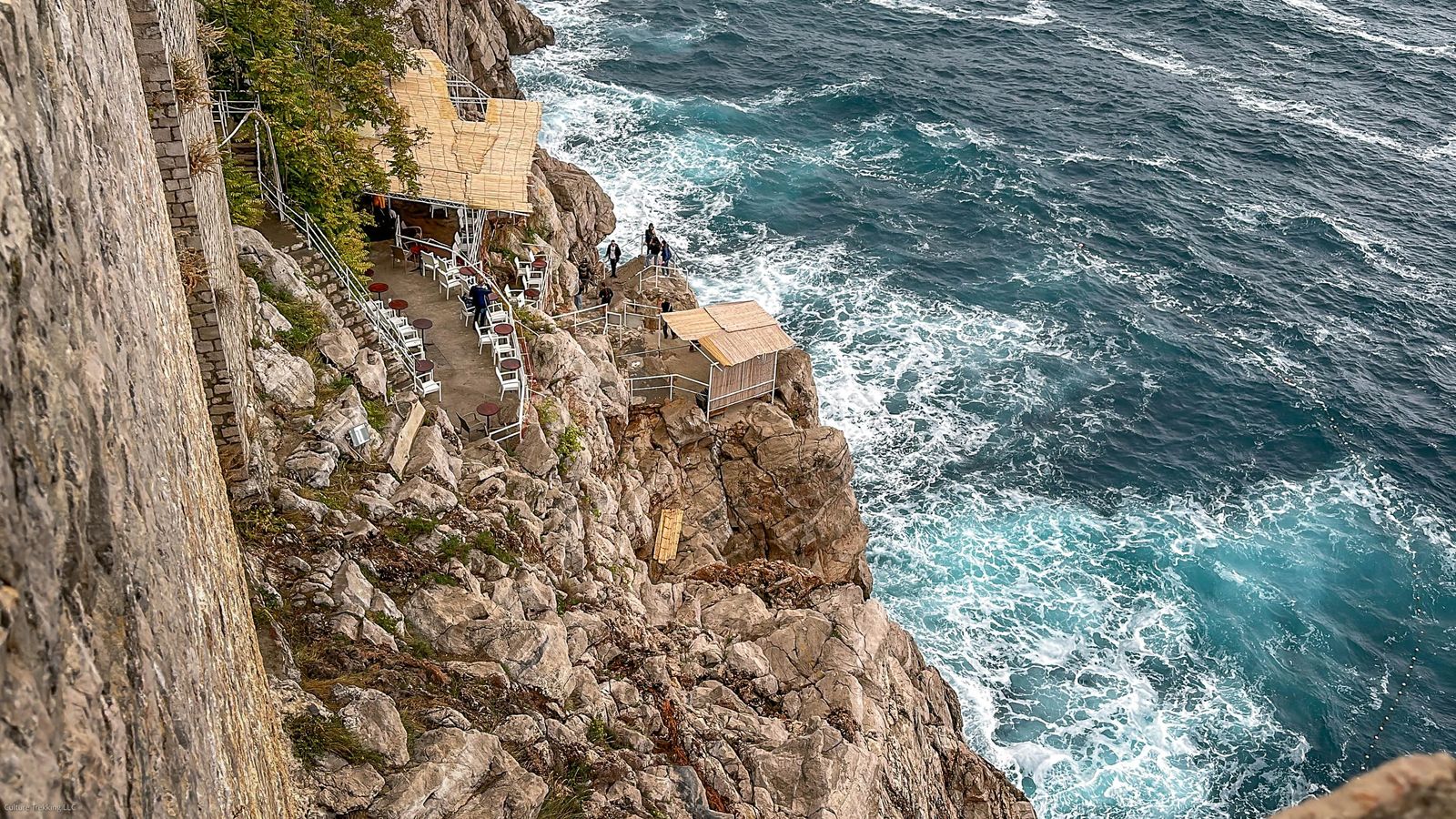
Snorkel & Eat At Buza Bar
There are two Buza bars along the City Walls of Dubrovnik, but if you want to snorkel off of the walls, then you will want to head to the second Buza Bar. The bathroom to change is about standing room only, so I would wear some moisture wicking clothing (think gym clothes) over your swimsuit or a nice flowy dress that won't look like you are nursing when it gets wet (this goes for men too ;)
You will need to bring your own snorkel gear, and will probably want to do the snorkel in the morning or at sunset when the fish are the most active. I wouldn't count on snorkeling if the weather is bad though, it can get pretty rough with the waves, and there are no lifeguards here so make sure you are confident in your ability to swim and climb up and down off the rocks.

Scuba Diving In Dubrovnik
Diving in Dubrovnik is truly exceptional, although I wasn't personally able to dive there because of weather, it is only my list to go back and experience. There are plenty of dive sites, as well as a Blue Planet Dive Center located right in Dubrovnik that has exceptional ratings and is a PADI 5 star resort.
The best time of year to dive is from May to August, as there is little chance of rain and the water temperatures are upwards of 60 F (15.6 C). The visibility around this time is around 65 ft (20 m), and the currents around Dubrovnik are generally low.
There are over 1000 islands off of Croatia, all of which have incredible reefs, underwater caverns, and canyons. You can see WWI AND WWII wrecks, a B-17 bomber, and many older ships. There is the abyss, S-57 wreck, Taranto Wreck, and the Little Afrika that I definitely want to go and see.
As far as marine life, corals here are particularly healthy - red coral clusters are in abundance. There are scorpionfish, octopus, damselfish, forkbeards, and lobsters.

War Photo Museum
The war photo limited museum is a place that I suggest everyone visit. It gives you a glimpse through the brave photojournalists that visit war torn areas and show you the reality of war and the people who really suffer during war.
This is a permanent collection of images of former Yugoslavia and the break off of Croatia, Bosnia and Herzegovnia and Kosovo. Just be warned that the images can be quite moving and terryifying all at once. It strips away the politics of war and shows the truth.
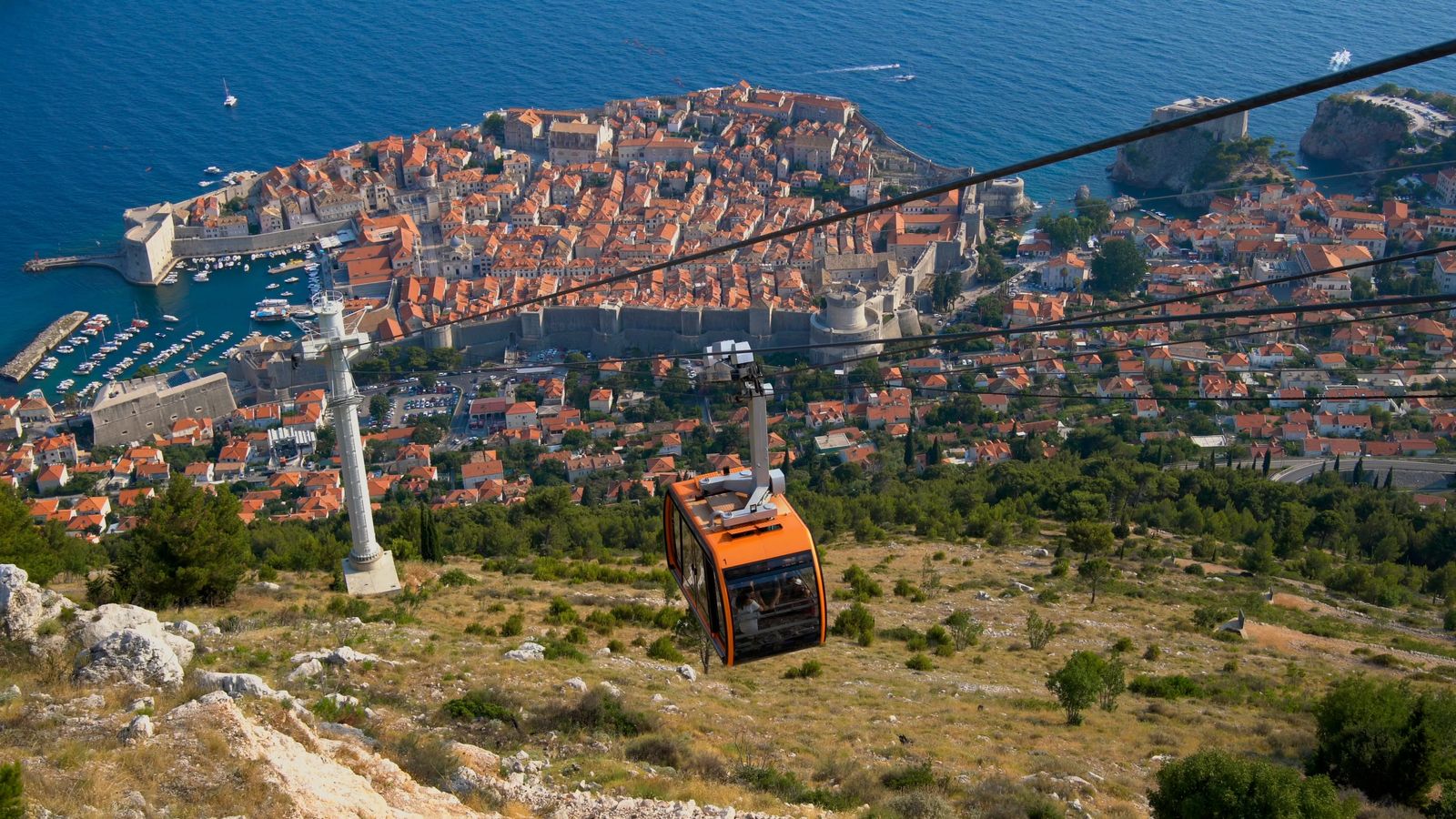
Hike Mount Srd & Dinner At Sunset
Mount Srd looms over the city of Dubrovnik, but was also a key part of how the city was so protected from the Slavs, Hungarians, Ottomans, and Turks. Now it is used as a popular hiking location that has well marked trails taking anywhere from 30 minutes to and hour and a half depending on your fitness level. The trail does get steep in some parts so make sure you are up for the challenge, and have some good shoes on. Also make sure you bring enough water as there aren't very many places to catch a break until you get to the top.
Once you summit the mountain, you can enjoy a nice dinner from a terrace that offers some of the best views of Dubrovnik. The cafe does get quite crowded early on though, so if you plan to do the hike for sunset dinner (highly recommended) then I would make sure to make a reservation.
If you aren't up for the hike, or want to make it a romantic evening, you can also catch the funicular up to the top of Mount Srd as well. As of 2023 it costs about 27 Euros to ride the funicular up to the top, this is one thing that is NOT included in the Dubrovnik Pass.
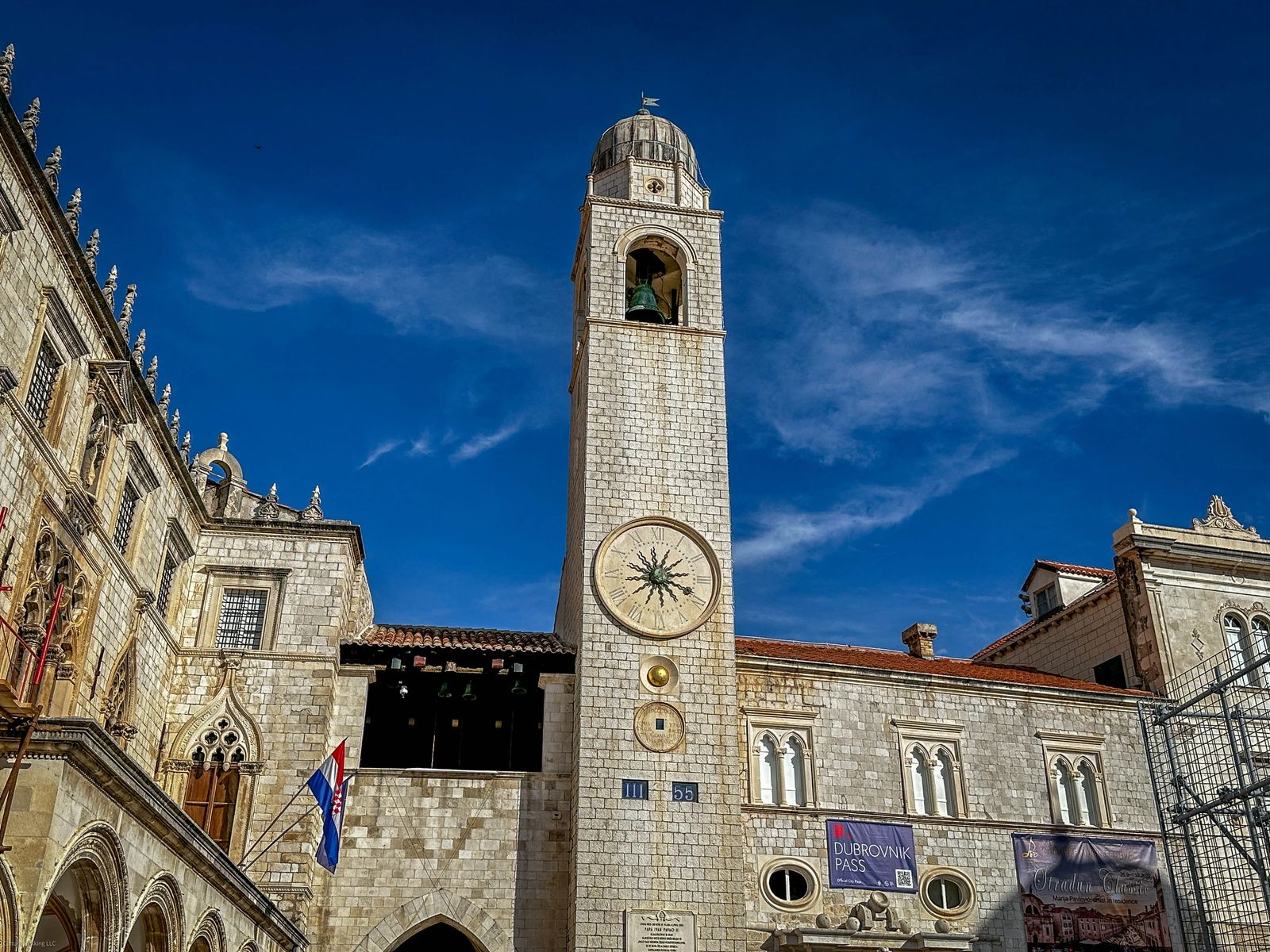
Luza Square and Clock Tower
Standing 131 feet high (31 m) is the clock tower of Dubrovnik, dating back to the 14th century it towers of Luza Square. The clock is a popular meeting place for groups, is located at the end of the Stradun (main walkway), and is right near Sponza Palace, and Dubrovnik Cathedral.
You can climb the clock tower for a fee, and at the top you will find the bronze statues of "Baro and Maro" the 'Zelenci' or two green men worn by the salty breezes of the Adriatic Sea. Just make sure you aren't in the clocktower when it strikes noon, the clock tower bells can be deafening if you are caught when the clock chimes.
The clock fell into disrepair in the 18th century until the Franciscan brothers repaired the clock to its current features, with the classic Octopus hands. If you look closely you can also see that the clock shows the phases of the moon (useful for a port city and noting the tides as well). For more than 100 years the same family has maintained the clock, passing down the tradition for generations (guess stair climbing is a family activity for them).
It is best to visit the clock in the early morning to get photos because otherwise you will be photobombed quite a bit. The square the clock reigns over, you will also find the mythical knight (Orlando's column) which I'll talk about down below in more detail.

Onofrio's Fountain
Because fresh water was so important to this city they actually had two Onufri's fountains in the city. The small Onufri's Fountain is right near the clocktower and the statue of Marin Drizic. At the other end of the stratum you will get the larger Onufri's fountain with the classic domed structure.
One of the easiest ways to conquer a city is to cut off their fresh water supply however the innovation and architects of Dubrovnik were able to combat that by building Onufri's Fountain. They also built large cisterns to hold both water and food.
Prior to the fountains being build, the roof of Sponza Palace was once used as a collecting roof for the cisterns for the fresh water that supplied the city of Dubrovnik. However, after several droughts, the authorities decided in 1436 that enough was enough and they hired Onufri Giordano De La Cava to oversee the construction. He built both of the fountains as well as an aqueduct running from a well some 12 kilometers away into the center of the city and that is how they ended up with Onufris fountain.
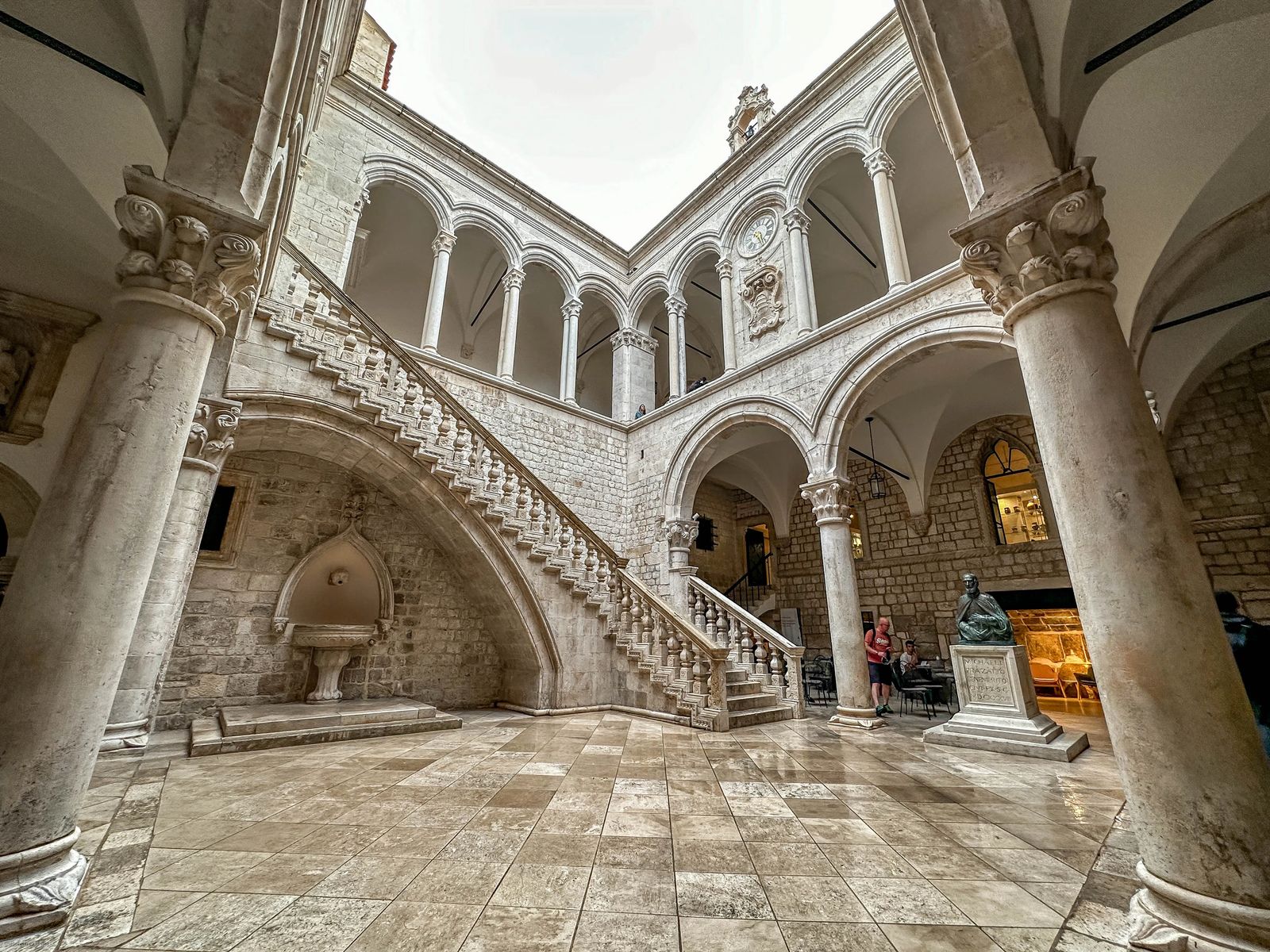
Rector's Palace
Built-in the late 15th century for the elected rector who governed Dubrovnik, this Gothic-Renaissance palace contains the Rector’s office and private chambers, public halls, administrative offices, and a dungeon.
During his one-month term, the rector was unable to leave the building without the permission of the senate. Today the palace has been turned into the Cultural History Museum, with artfully restored rooms, portraits, coats of arms, private hand carried carriages, and coins all showcasing the glorious history of Ragusa.
In the atrium is a statue of Miho Pracat, who gave his wealth to the Republic and was the only commoner (rich fisherman) in the 1000 years of the Republic’s existence to be honored with a statue (1638).
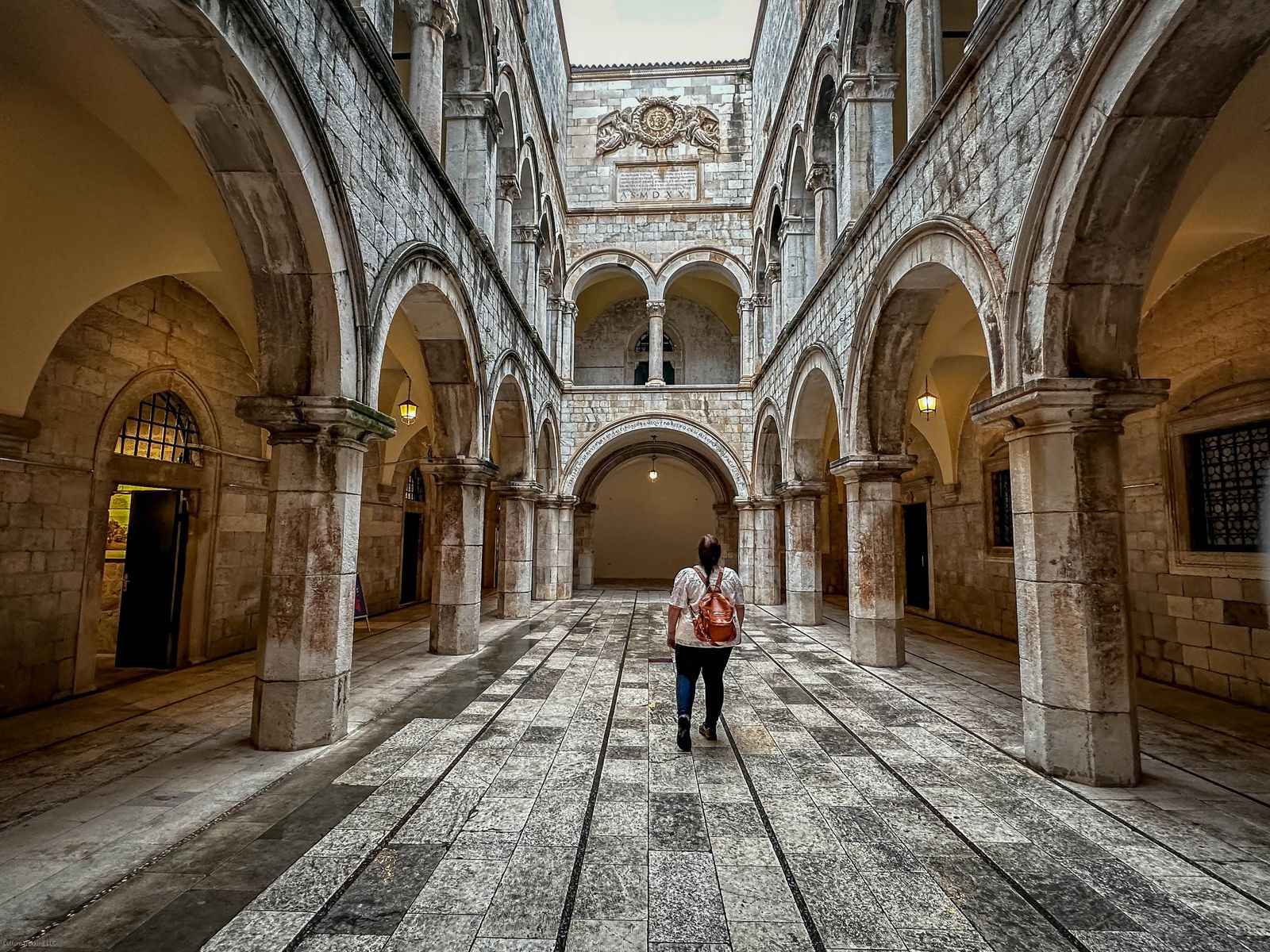
Sponza Palace
Built in 15th century, served as a sort of farmers market for merchants and traders until the 20th century. It is located right off the Stradun and next to the clocktower. The entrance fee is included in the Dubrovnik Pass. As of this year you can only visit the bottom floor, where there are some small photo exhibitions. The photo above is taken in the atrium, but other than that - for now it is likely a place you could skip of you are pressed for time.
If you do visit make sure to look at the archway there is an inscription that says, "please don't rip each other off". Each door has a different photo of the 'offices' of a particular items being imported or traded.
This was one of the few buildings to survive the 1667 earthquake. Now it serves as the city archive with 100,000 documents that date back all the way to the 10th century. Sponza Palace was used as a mint, armory, printing house, school, and seat of the trade in Dubrovnik.
The roof here was used as a collection duct for providing fresh water to the city prior to the fountains being built.
Over time, it changed its purpose so that it was also a mint, armory, printing house, school, and seat of the Dubrovnik trade. The Sponza Palace is also called Divona. The roof of Sponza palace was also once used as the collecting roof for the cisterns for the freshwater that supplied the city of Dubrovnik.

Dubrovnik Cathedral (Cathedral of the Assumption)
This Roman Catholic Church is the largest Baroque (16th-17th century) church in Dubrovnik. While the original churches of wood date back to the 7th century, the current structure was partly funded by Richard the Lion Heart. King Richard helped build this church as a sort of votive for surviving a shipwreck near here when he was returning from his 3rd crusade. It isn't just the architecture but the artwork inside that is a must see. As you enter you are greeted by a facade with the Patron Saint Blaise as well as Joseph with Jesus.
Make your way to the alter and there is a relief 3-fold painting of the Ascension of Mary by the Renaissance painter Titian. Titian was a world renown painter from Venice in the 16th century, and 'painting nomad' as most of his clients were international. Ironically he was good at both the religious paintings as well as the profane subjects of the time. It is his work of the ascension of Mary in the Santa Maria Gloriosa dei Frari in Venice and the full sized painting of the Roman Emperor (unique way of painting in that time) that truly sealed his international fame.
The real gem and relic of this church though, are the 182 literary items from 10th-17th century and the gold-plated bones of St. Blaise you will find inside. Talk about going out in style....sheesh...
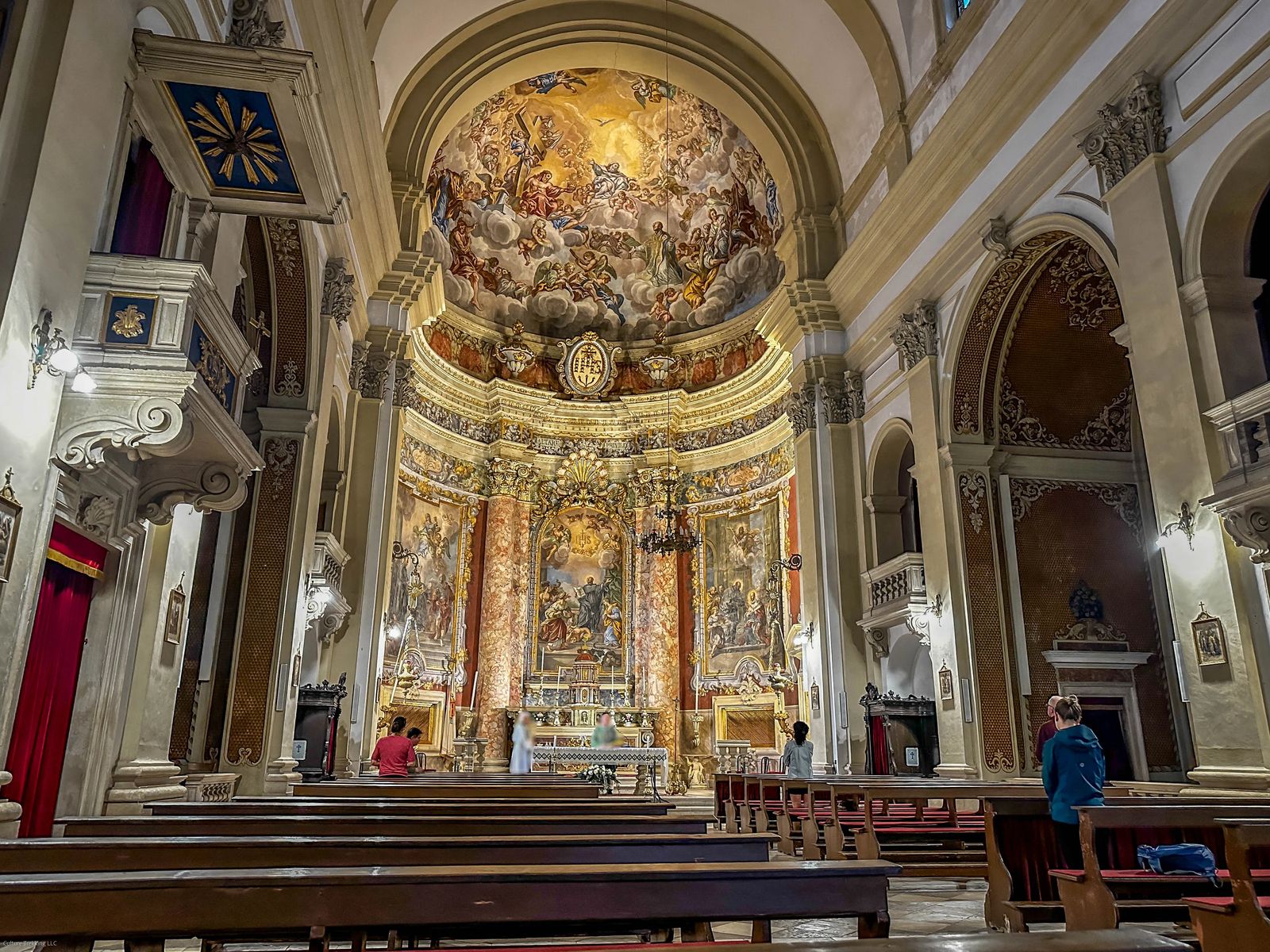
Saint Ignatus Church
The Baroque stairs actually lead to St Ignatius church in Gundulic Square and are connected to the Jesuit college. The Bishop of Dubrovnik asked the college to be opened in 1555. After a lot of setbacks, earthquakes, and lack of funding, Ignazio Pozzo a famous Jesuit architect and painter came to the city in 1699 and the church was finally finished in 1725.
If you actually use the stairs to go inside the church you will find magnificent Baroque frescoes with scenes from the life of St. Ignatius de Loyla by Gaetano Garcia. This is also where you will find the oldest bell in Dubrovnik's cast in 1355.
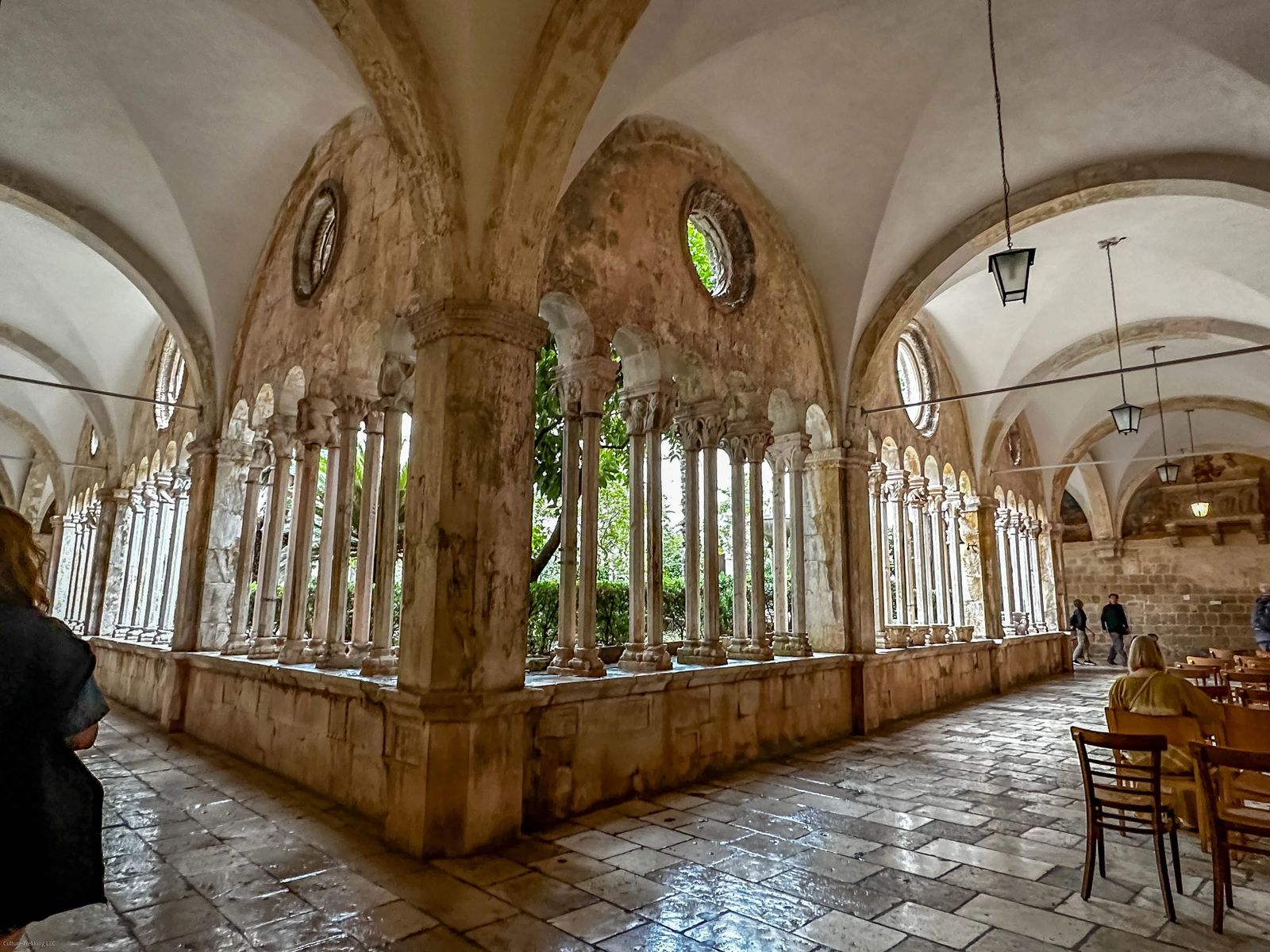
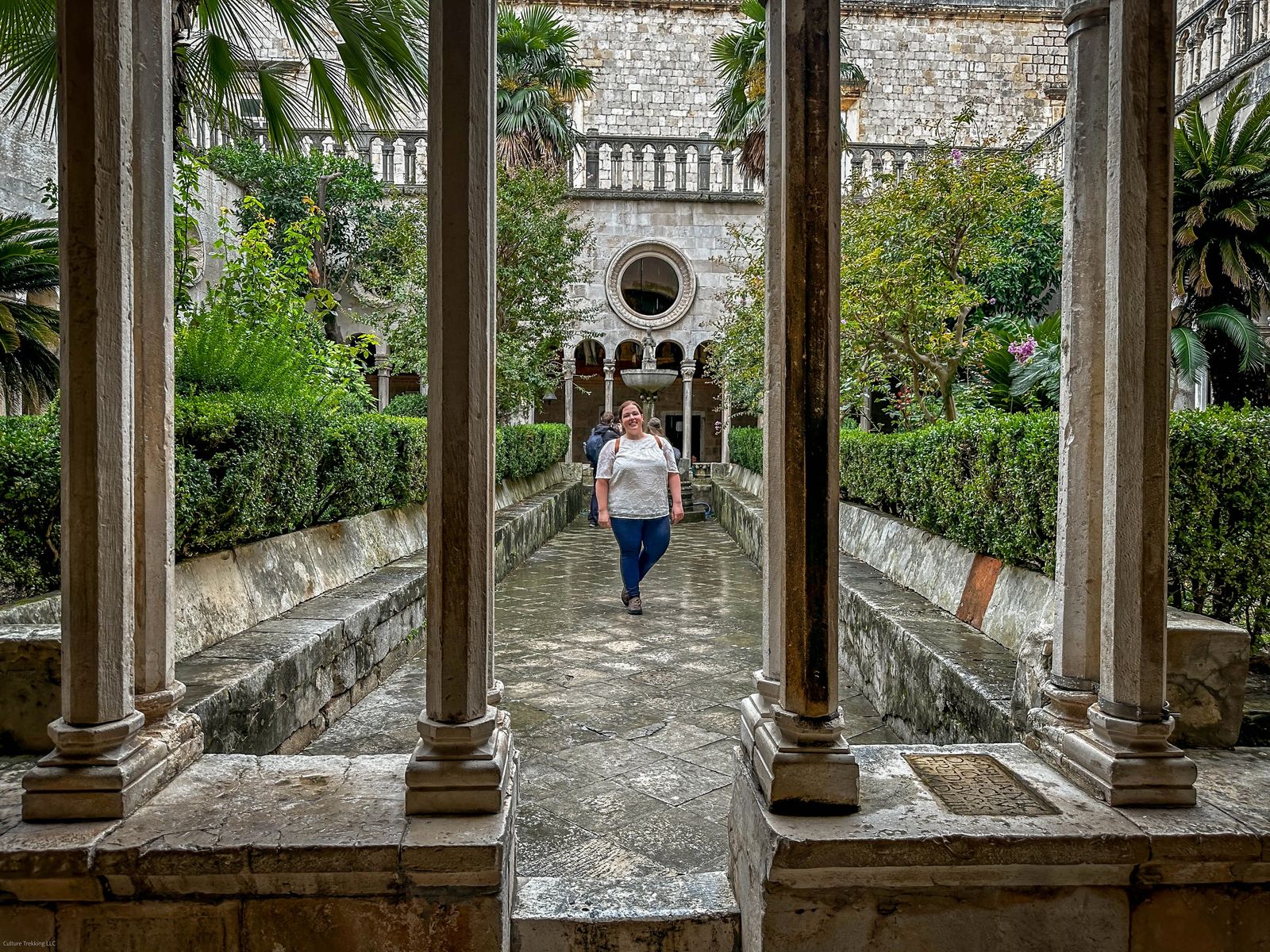
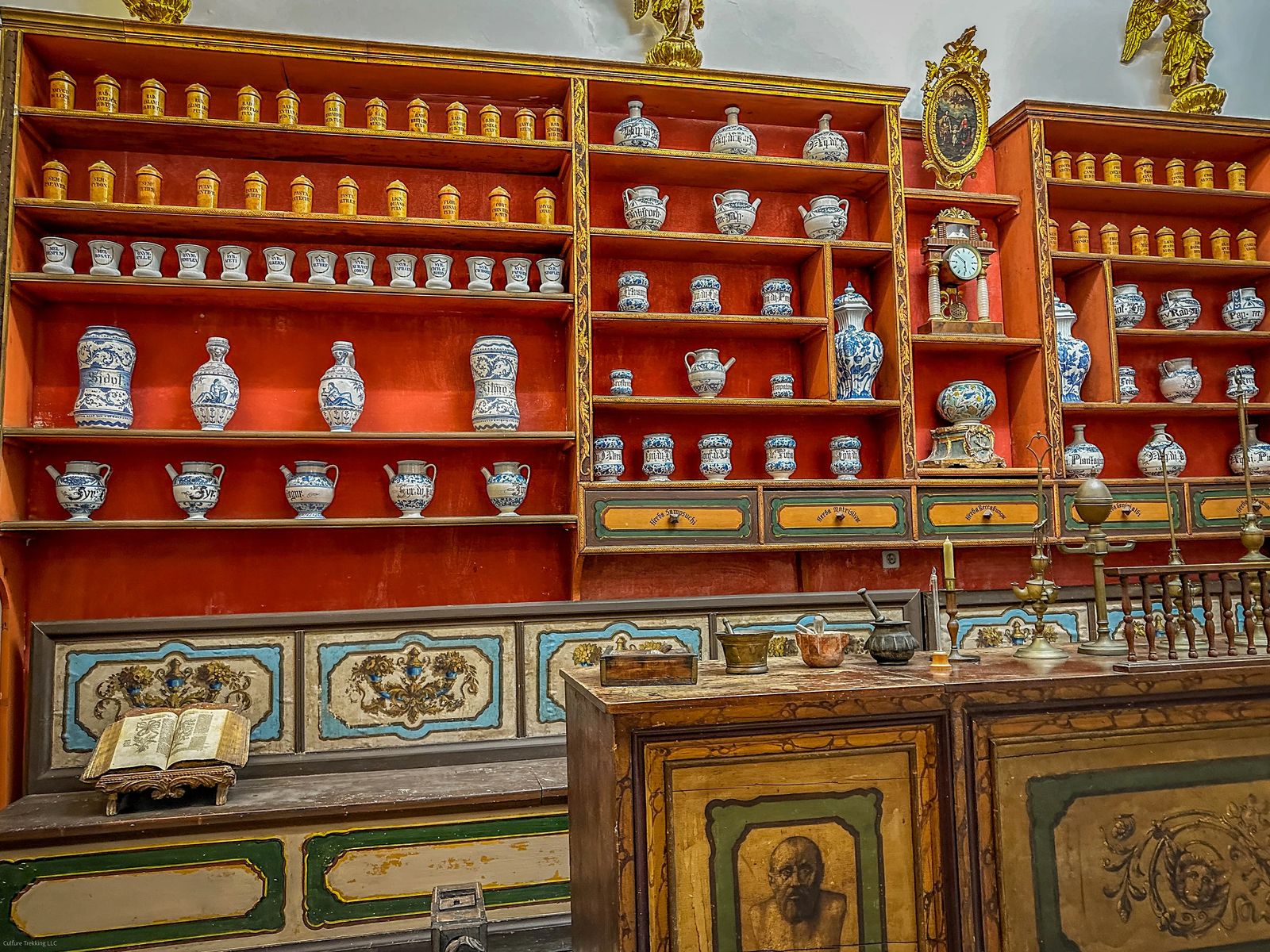

Franciscan Monastery (Oldest Pharmacy In Croatia)
Being a Physician Assistant, I'm always fascinated by how Medieval Medicine and pharmacies worked, the Franciscan Monastery is no exception. The monastery complex is open from 9am - 6 pm, but the pharmacy inside is open from 7 am to 8 pm. Once you are inside the complex (included in your Dubrovnik Pass) there is a stunning courtyard flanked by archways with different faces at the top of the columns.
If you only walk around this courtyard and don't explore any of the adjoining rooms it will take you about 10 minutes. The adjoining rooms house old artifacts of both the Pharmacy and religious relics. Keep in mind that photos aren't allowed in the Pharmacy.
There are three main areas to explore inside the monastery: the Baroque Church, the Pharmacy (which is the third oldest pharmacy in the world) dating back to 1317, and the library with its tower. After the earthquake in 1667 much of the monastery had to be rebuilt.
The Library houses over 1200 manuscripts, some of which date back to the 10th century. Don't miss the church's two cloisters, one built in the Renaissance style and the other in the Romanesque and Gothic style.
During the Yugoslavian war, the fountain inside the courtyard, provided protection and fresh water to the citizens that were taking shelter there during the 7 month siege of the city that failed.

Dubrovnik Old Town and The Stradun (Stari Grad)
This is the busiest part of Dubrovnik, and the main walkway, or Stradun, that you can walk down in about 5 minutes. During the day it is bustling, and even into the night there are visitors and locals alike that enjoy the warmly lit walkway with a drink.
Before the 13th century, this was once a natural moat that separated Ragusa (or Dubrovnik) from the mainland. After the 13th century is when it was filled in, the city expanded, the walls built and the town fortified to what we know it to be today.
Along the Stradun you will find ice cream shops, candy shops, Game of Thrones stores, restaurants and coffee shops (all VERY expensive). There are a few clothing stores featuring local distributors and some chain clothing and jewelry stores.
If you go down the alleyways you will find the cheaper restaurants, Irish Bars, rental properties, and small museums that really tell the history of both the old and modern history of Dubrovnik.
Be careful when walking on the Stradun as the limestone has been worn and polished down by so many visitors. When it rains here, even in shoes with good traction I found my feet slipping out from under me if I wasn't acutely paying attention (which is hard to do in this city).
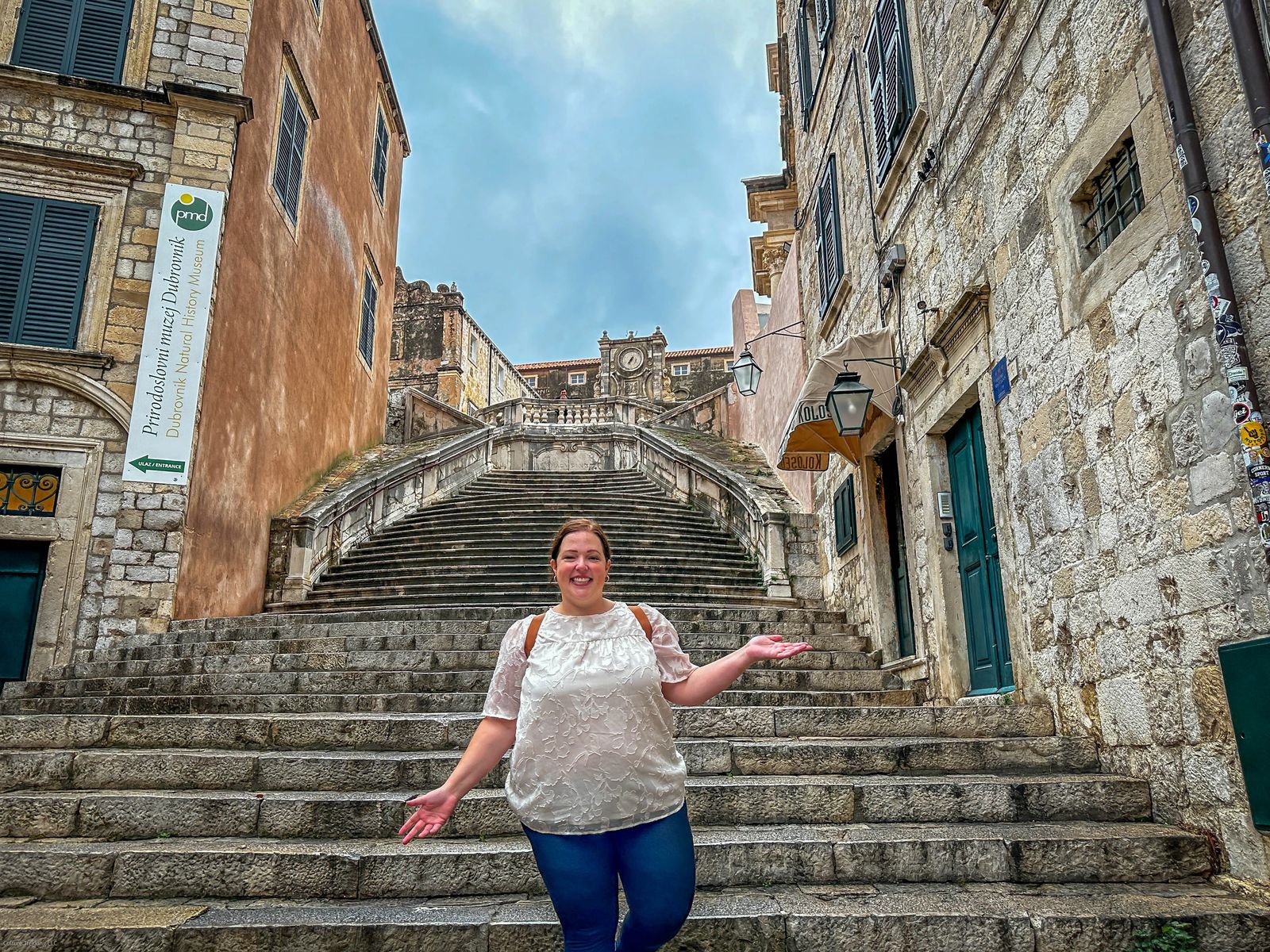
Jesuit Stairs
Visit BEFORE 9 am or after 5 pm or the entire thing is going to be filled with people, and it will be hard to get a photo even with long exposure.
These stairs were designed by Ruder Boskovic Field, and are compared to the Pizza di Spagna in Rome. It leads to Gundulic Square (where the Jesuit College is), the Gundulic family financed all the buildings, but eventually had a falling out with many of the teachers at the college.
While you are here, right across from the stairs is the Dubrovnik Natural History Museum as well which is worth a visit.

Jesuit College
The Collegium Ragusinum or Jesuit College was built in 1555 and permanently closed in 1773. It is considered to be one of the finest Baroque complex in Dubrovnik. It was after the 1667 earthquake in Dubrovnik that destroyed so many buildings, including the college that killed many of its students that the college began to decline. The college did teach the famous scholar Ruder Boskovic, and today it is used as a Highschool gym.
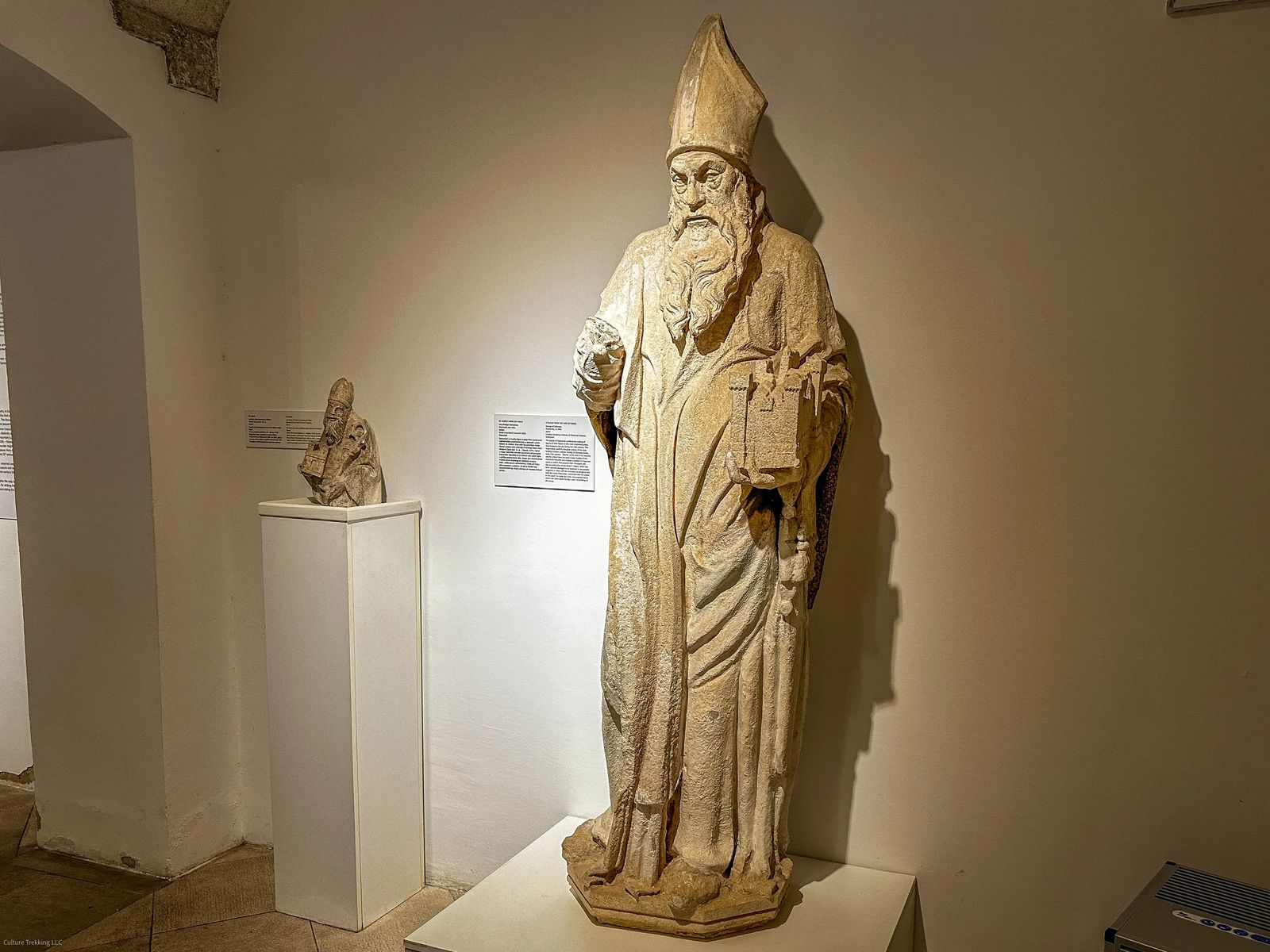
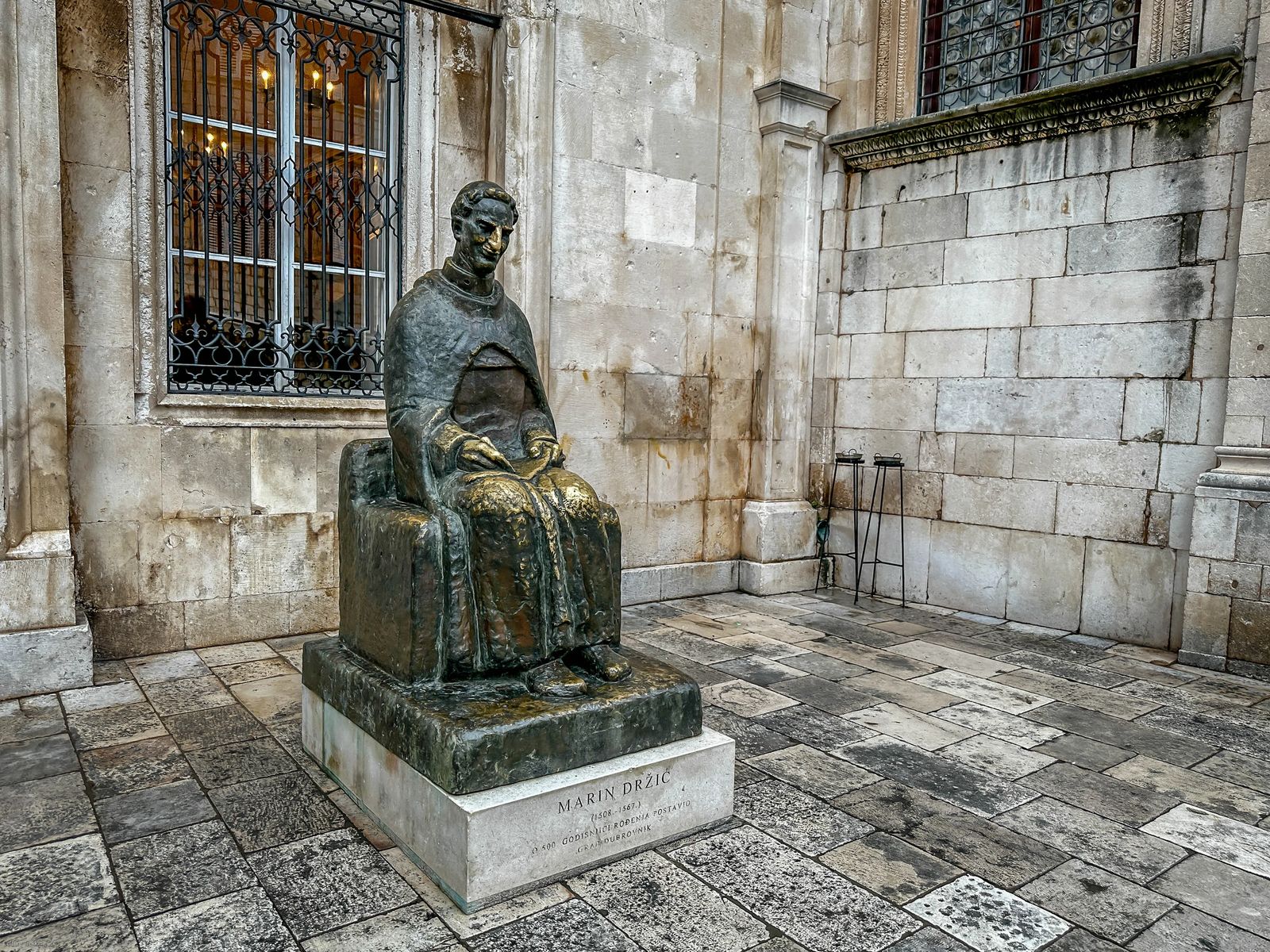
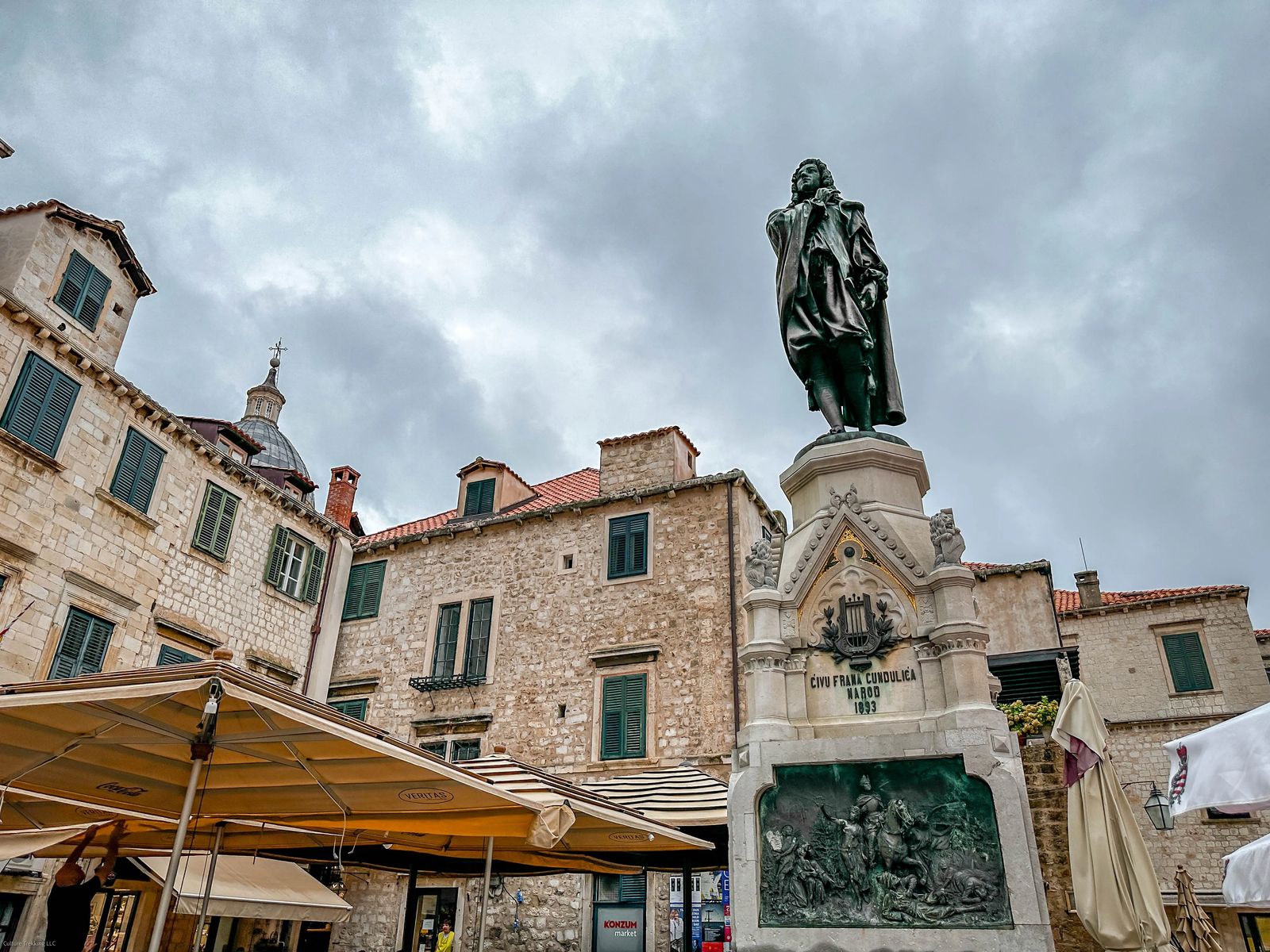

Statues in Dubrovnik
From left to right these photos are some of the statues that you can see in Dubrovnik. Imagine being so revered by history that your statue survives centuries of history. Knowing who these people were at the very least, and what was important to the Ragusan and Dubrovnik society here is important for understanding the culture.
St. Blaise
Saint Blaise is known as the patron saint of Dubrovnik. According to history, when the Venetians arrived in the city's harbor under the guise of exchanging food and wine, they were actually planning to attack the city. Luckily, Saint Blaise learned of their plan and warned the city officials, saving the city from being overtaken. Interestingly, every citizen of Dubrovnik was expected to participate in protecting the city, and keeping secrets that would harm the town was punishable. Saint Blaise's bravery and actions have been celebrated since then, and his image can be seen throughout Dubrovnik. His feast day is on February 3rd, so if you're in town during this time, it's a great opportunity to visit the church and learn more about the city's history.
Marin Drizic
Rubbing the nose of the Shakespeare of Dubrovnik Marin Drizic is said to bring you back to this city so make sure to do that before you leave
Ivan Gundulić
Born in 1589 to a noble Ragusan family, Ivan Gundulić was a senator and senior diplomat. He was also a revered Croatian Baroque Poet. He is known for writing Tears of the Prodigal Son (1622), Dubravka (1628), and Osman a baroque epic along with many others.
Orlando's Column
The Clocktower overlooks Orlando’s column (a mythical knight of Dubrovnik) 101ft (31m). He was built in 1444 and is said to have protected the city of Dubrovnik. If you head into Sponza Palace (across from the column) there is an entire exhibition on him.

Farmer's Market
Located right across from Sponza Palace down an alleyway and near Ivan's statue you can find the Farmer's Market. If the weather is good you will find lavender (Dubrovnik is known for their Lavender), Arancia (candied orange peels), wooden frogs (great stocking stuffer), and fresh fruit that I personally stocked up on to save some money on breakfast.

Ethnographic Museum
Open: 9 am-6 pm, closed Wed
Since 1991 the Dubrovnik Republic’s granary, popularly known as Rupe/The Holes, which derives from the name for the underground grain storage areas carved out of bedrock or tufa has been open to the public for touring. Built in 1590, this is a three story structure with 15 food storage pits on the ground floor, and the upper floors were used for drying food and herbs.
The Ethnographic Museum of Dubrovnik have 6,500 artifacts from the Dubrovnik and Croatian poeople that lived in the area. You can see traditional clothing from Dubrovačko primorje, the Elaphite islands, Konavle, Mljet, Lastovo, Pelješac, Korčula, Rijeka Dubrovačka and Župa Dubrovačka.
The ground floor shows the way grain was stored, while on the first and second floors the traditional economic activities.
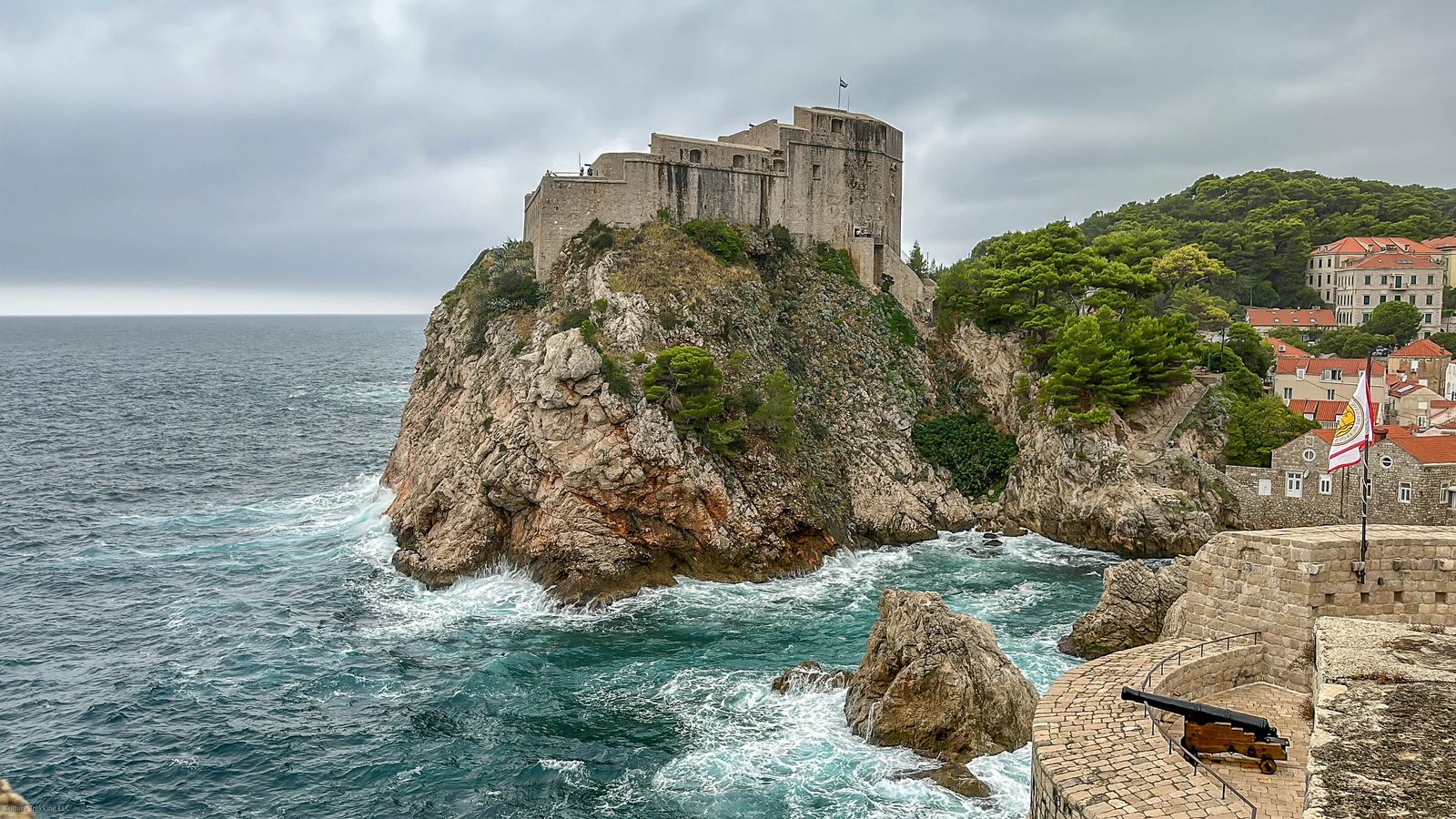
Lovrijenac Fortress (Fort of St. Lawrence)
Open 8 am - 7 pm
Lovrijenac Fortress is one of the most fascinating stories of the fortifications of Dubrovnik. Standing at 131 feet (40 m) above the sea this fortress was built when the citizens of Dubrovnik caught wind (in the 11th century) that the Venetians were going to build a fortress on these rocks as a way to control the city more tightly.
Because there was a law in Dubrovnik that encouraged each citizen to be an ambassador of protection for the city, they all came together to build a fortress of their own. With every citizen helping for the good of everyone, the fortress was built within 3 months.
The walls are defended by ten cannons with the inscription above the entrance to the fortress reading "Non Bene Pro Toto Libertas Venditur Auro" - "Freedom cannot be sold for all the gold of the world".
If you are in Dubrovnik in the summertime, and have a little more time in the city, they do hold performances of Hamlet and others here. This was also where Game of Thrones digitally placed the Red Keep, or the main castle featured in the films.

Foundry Museum in Minceta Tower
If you come down from the wall into the town portion, there is a wooden door with an entrance into the Ancient Foundry Museum. Head towards the basketball court, there is an unassuming green door you can enter and see the excavated area where you can learn about the secretive and powerful firepower that defended Dubrovnik for centuries. Inside you will learn about the economic and metallurgic powerhouse that Dubrovnik was.
Inside you will see a 15th-century forge, the mold-casting section, water basins, a sedimentation channel, and a sand depository. This is where gunpowder was prepared, bronze was cast, and church bells were made. You also see how cannons were made, as well as bullets. This metal foundry was used until the 17th century when it was buried during the earthquake. It costs about 30 Kuna to get in and is separate from the City Walls tour.

Lokrum Island Day Tour
If you want a quick adventure from Dubrovnik, you can hop over to Lokrum Island on a quick 10 to 15-minute ferry ride from the Old Port. To visit it costs about 5 Euros and the ferry travels back and forth about four times in an hour.
It is said that Richard the Lion-Heart was cast ashore on Lokrum island after his shipwreck in 1192 when he was attempting to return from the crusades. In gratitude to the Lord he built a church in thanks here. Thus was born the 12th century Benedictine monastery here that provides a fascinating look into the history of the islands.
It is said that Napoleon built a fort on this island, it has its own lake, a few hiking trails and is a great spot to both Kayak and snorkel at. The intertidal zone on Lokrum islands gives a home to some unique creatures such as: the rock sea urchin, Mediterranean red sea star, mermaid's wine glass algae, Neptune grass, damselfish, along with eels, lobsters, octopus and crabs.
There is a legend of the Imperial pearls here as well, a Bavarian duchess named Elisabeth, put her 'old tired pearls' in a shoe to help them regain their life. Unfortunately she died before being able to retrieve them, and the island still watches them for her glittering at night, and protected by the sea foam during the day.
If you are a scuba diver, there are a few shipwrecks out here as well you can explore.
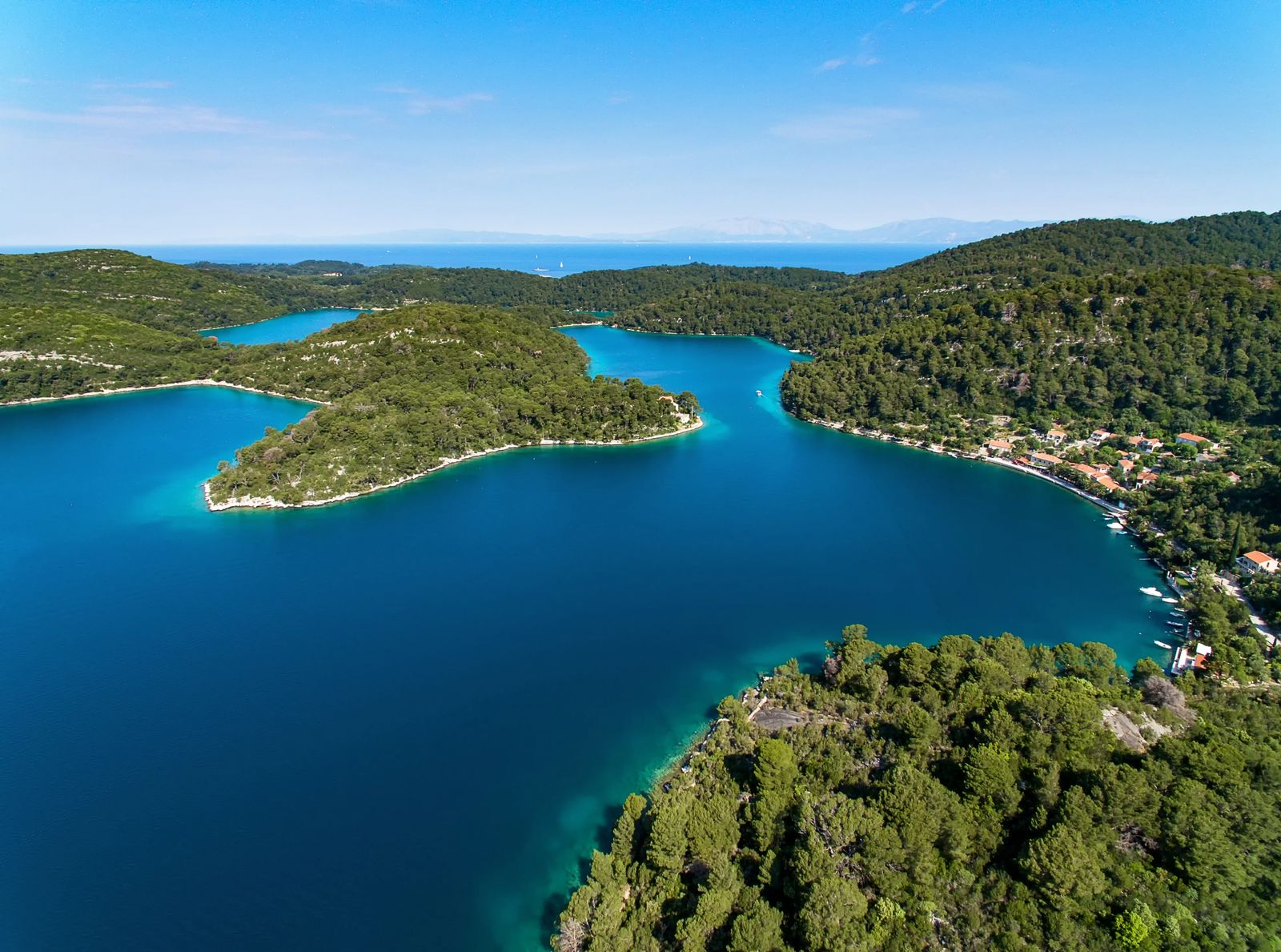
Island Hopping In Dubrovnik
The blue, crystal clear waters of Croatia are sought after for Scuba Divers and Super Yachts alike. Island hopping is a popular day activity for many that visit the city. Take a ferry to Mljet the green island known for biking and hiking. Hop to Korčula on a ferry where you can taste divine wine and olive oil. Visit the largest island Šipan by ferry as well, with some of the BEST beaches near Dubrovnik.
There are private tours available, so you can make your own itinerary without having to wait for the ferry, and stop to snorkel or explore wherever you like.
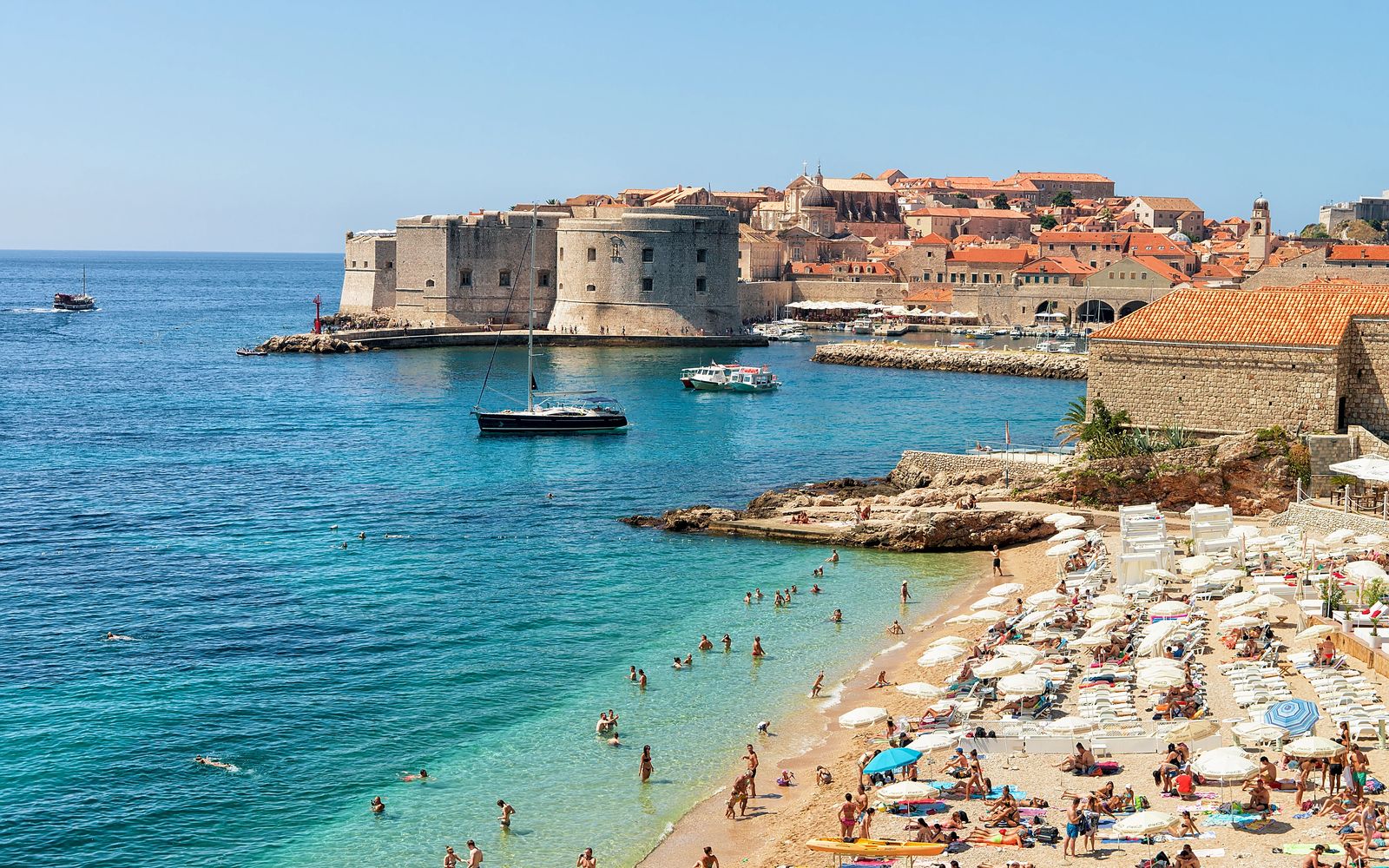
Beaches in Dubrovnik
If you are looking to lounge on a beach with crystal clear waters near Dubrovnik, then Banje beach is your best bet. The beaches here are quite pebbly and can be rough on the feet - so bring some water socks to help with that. From Banje Beach you can jet-ski, go parasailing, or play some volleyball. There are also plenty of bars close by if you want a drink and to doze off in the sun for awhile (just don't forget sunscreen ;)
If you want a beach that is a little less crowded, take a short bus ride down to Sveti Jakov. It is a more secluded beach with not as many amenities, but is a popular spot for snorkeling surrounded by cliffs.
Another great option for those who like to go off-the-beaten-path, is Pasjača Beach. Located about 30 minutes outside Dubrovnik, this beach is not for the faint of heart as it requires a steep descent into the beach. It is worth the trek though, because of virtually being able to have the place to yourself if you time it right.
Other noteworthy beaches you might try are Copacabana Beach, Lapad Bay Beach, and Cava Beach. While I'm not one to really sit on a beach and do nothing, the quality of Snorkeling all along the coast here would make any beach visit worth exploring.

Best Places To Eat In Dubrovnik
While spending three or four days in Dubrovnik, these are the places I have personally eaten at and found it either budget friendly, interesting, or incredibly delicious. Dubrovnik is known in Croatia as a foodie city compared to Split that is known more for its nightlife, so I would definitely try to save up and eat at the 360 restaurant.
Breakfast
Grab fruit from the farmers market, get a place that has coffee in your room. Many places don't open til later in the morning, so if you are an early riser I would just fend for yourself. You can also pick up a few things at Pemo Market for chilled coffee and drinks, fruit, fruit smoothies, and croissants.
Lunch
For something quick and budget friendly on the Stradun try Tavulin Restaurant to try the Black Risotto (squid ink), they also have decent vegetarian options. I would say this is about a 6/10 rating for me, but it is good enough if your short on time and want something edible that won't break the bank.
However, I REALLY LOVED Capun restaurant at the top of the Jesuit stairs. Kapun serves traditional Croatian dishes with a modern twist. They have outdoor seating that is both shaded in the summer and heated in the winter months.
Dinner
For a bougie experience go to 360 Restaurant. Make reservations at least 3 months in advance as this is a Michelin Star Restaurant in 2022 with incredible views of the Dubrovnik Port.
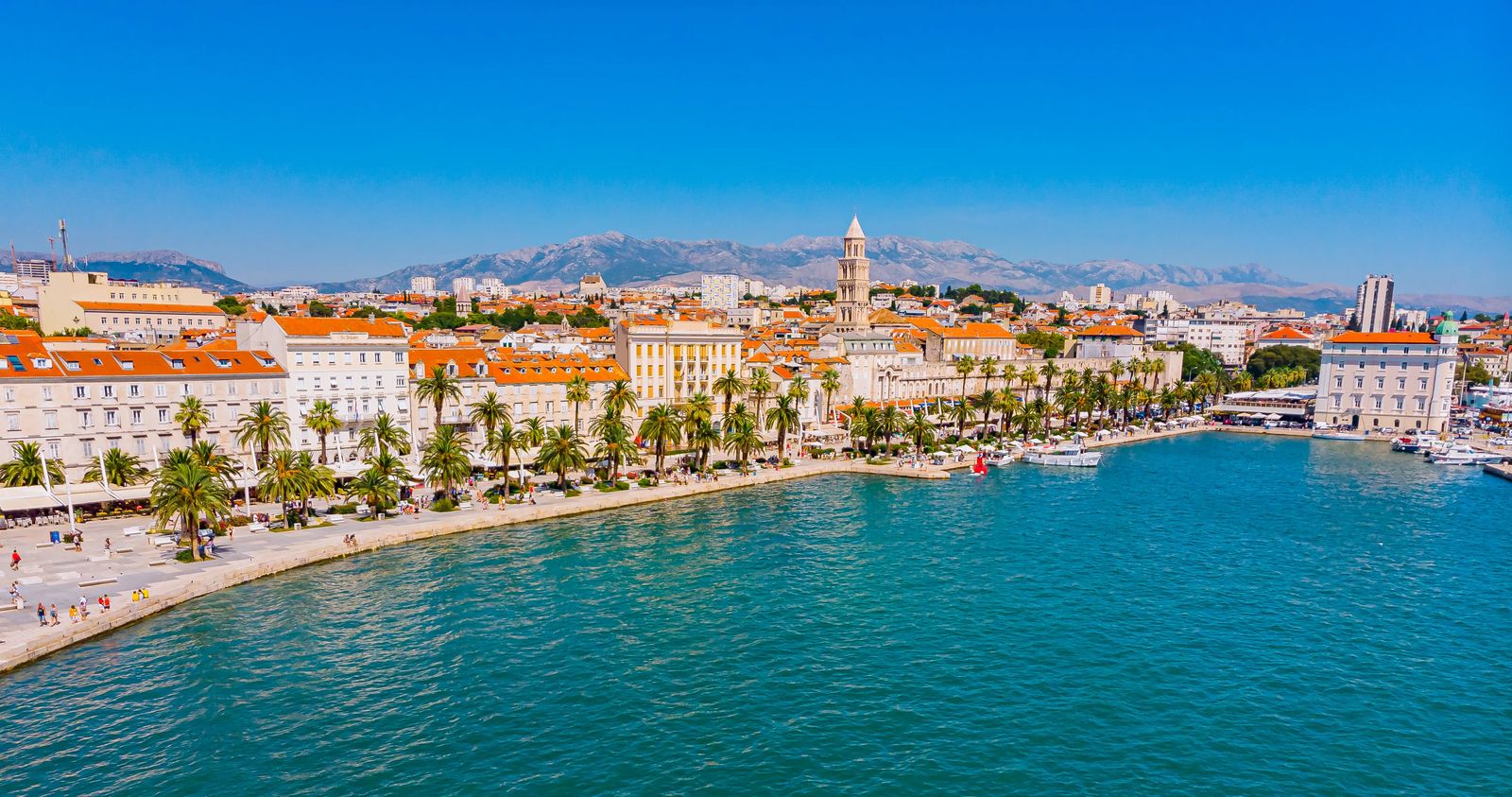
Day Trips From Dubrovnik
Dubrovnik is a great home base for MANY day trips to many areas in the Balkans. You can pop over to Split on the new bridge that connects Dubrovnik to Split without having to cross a border into Bosnia & Herzegovina. See the former Emperor Diocletian's Palace turned modern Christian city.
Mostar might require an overnight trip but could also be a long day trip from Dubrovnik as well. This Ottoman and Christian split city is known for its rebuilt bridge, and was at the heart of the Yugoslavian wars.
A day trip from Dubrovnik to Kotor is another popular port city for cruise ships and is known for its many cats that wander the city, gorgeous food experiences, Our Lady of the Rocks Cathedral and being able to wander the medieval city.
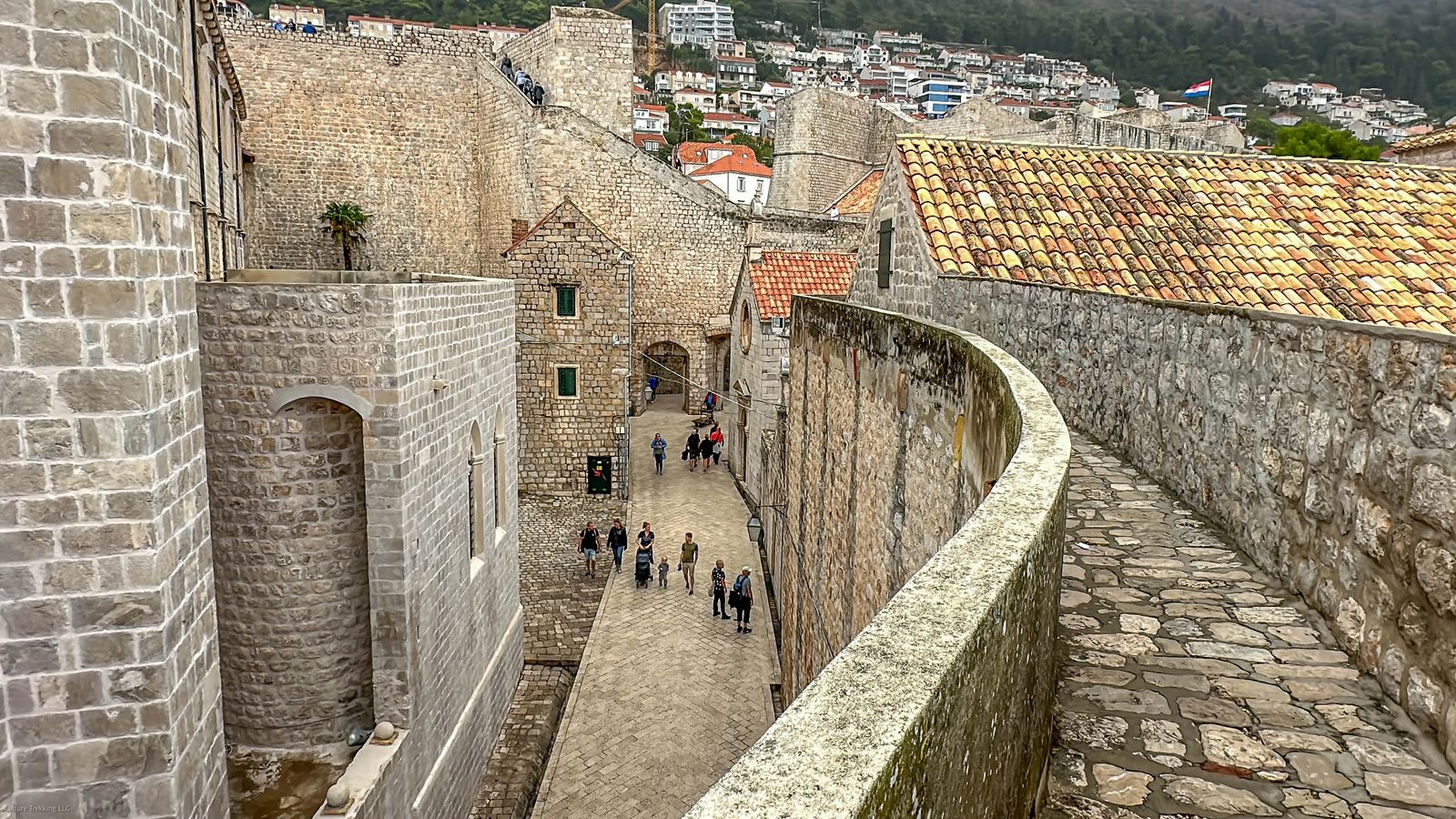
My Takeaway on Visiting Dubrovnik
No matter what you decide to do in Dubrovnik, there really is something for everyone. Wandering the streets felt like I was transported into a medieval city with an underlying rich history that many people miss. While I did feel it lost a bit of its charm during the day with hoards of cruise ship tourists, it was the quiet moments in the mornings and evenings that I really treasured. My favorite part was walking the city walls and when I go back to Dubrovnik I will be making the beaches, island hopping, scuba diving and snorkeling a priority.
Let me know if this article was helpful in planning your trip, or leave a comment for other travelers so they know what to miss or hit during their visit as well.
Guided Tours of Dubrovnik
Like it? Pin it for later! Sharing is caring ;)
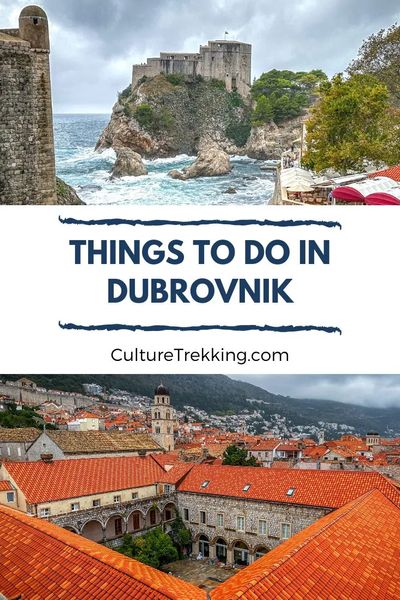.jpg?fit=outside&w=1600&h=2399)
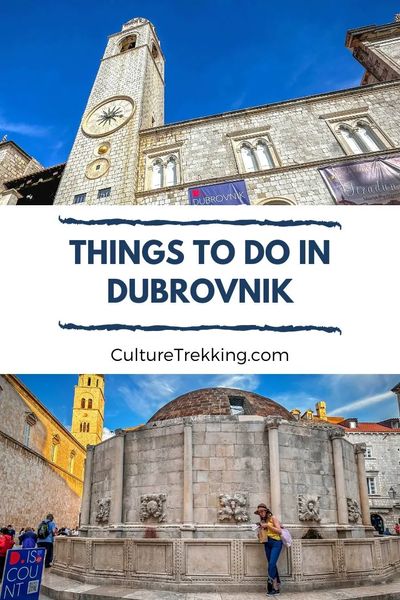.jpg?fit=outside&w=1600&h=2399)
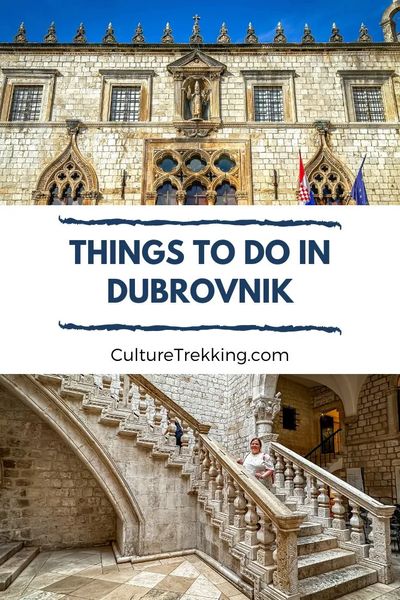.jpg?fit=outside&w=1600&h=2399)
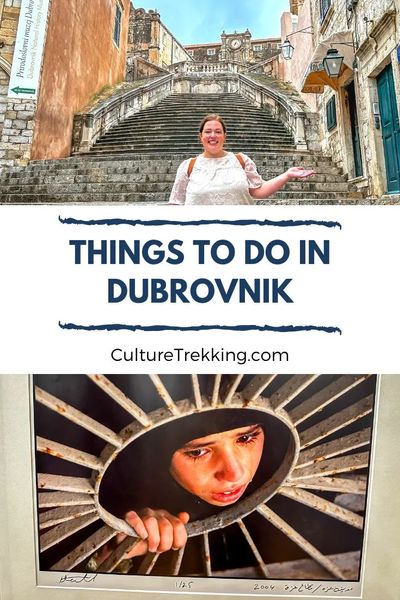.jpg?fit=outside&w=1600&h=2399)
.jpg?fit=outside&w=1600&h=2399)
Where to stay in Dubrovnik
Latest Articles On Culture Trekking


Welcome to Culture Trekking!
My name is Janiel, I specialize in solo female travel, cultural connections, sustainable adventures, food and history to help make your travel experiences fun, meaningful, and delicious. My experience in travel, and my personal story have allowed me to get published in Fodor's Travel, Atlas Obscura, Metro.co.uk, Trip Advisor, and multiple Podcast interviews. You can find me on pretty much every social media channel YouTube, Instagram, Twitter, Facebook, Pinterest, TikTok. To read more about me and my story click here. If you are a brand and would like to work with me, click here.












